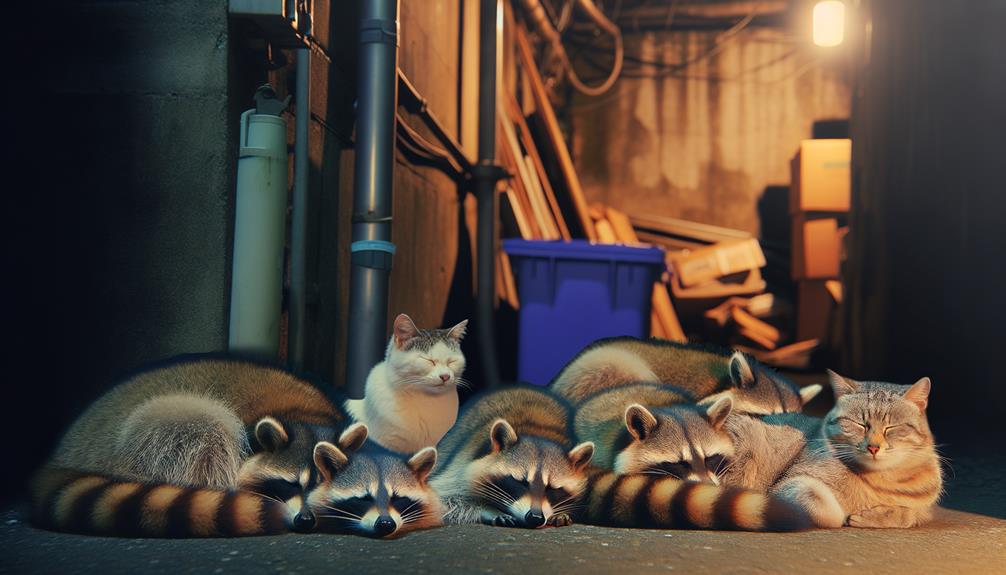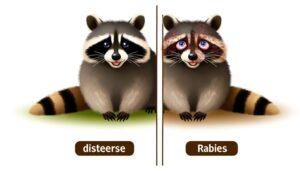How Do Raccoons and Cats Sleep Together Peacefully?
While raccoons and cats are both nocturnal, they typically lead solitary lives. Interactions occur mainly due to food-driven motivations.
Raccoons, opportunistic eaters, may intrude on cat territory to access food, leading to potential conflict. Unusually, situations may arise where cats and raccoons sleep together, influenced by factors such as perceived safety, territorial acceptance, and resource availability.
However, due to their unpredictable natures, each experience varies. Management of cohabitation and understanding inter-species behaviors are essential to prevent harmful interactions.
For further exploration into their behaviors and safety measures to contemplate, proceed on.

Key Takeaways
- Raccoons and cats can co-sleep if the cat perceives no territorial invasion and feels safe.
- The availability of food and water resources can facilitate co-sleeping between the two species.
- Raccoons are opportunistic eaters and might invade cat territory to access food, potentially causing conflict.
- Despite possible co-sleeping, interactions between raccoons and cats can be unpredictable due to their different communication methods.
- Securing outdoor areas at night and providing separate sleeping and feeding spaces can help manage cohabitation safely.
Understanding Raccoon Behavior
To understand the likelihood of raccoons cohabiting with cats, it is essential to first explore the complex behavioral patterns of raccoons.
Raccoons are primarily solitary and nocturnal creatures that are known to be highly dexterous and intelligent. Their behavior is often dictated by food sources, and they have a penchant for raiding trash cans and pet food. However, their interaction with other species, including cats, is usually incidental and not necessarily aggressive unless threatened.
Raccoons typically seek out warm, safe spaces to rest during the day, which can sometimes include homes and buildings. Their adaptability and opportunistic nature make them capable of cohabiting with other species, although this is not their preferred behavior.
Cats and Their Territories
While examining the interactions between raccoons and cats, it is important to take into account the territorial nature of felines and their responses to potential intruders.
Cats are known for their solitary, territorial behavior. They tend to mark and defend their territory, usually a fixed area around their home, with strong dedication. This behavior is primarily driven by their instinct to protect their food sources and to guarantee a safe space for rest and reproduction.
Intrusions by other animals, including raccoons, may trigger defensive responses in cats, ranging from mild aggression to avoidance. Additionally, the size of a cat's territory can be influenced by several factors such as the availability of food, presence of other cats, and the cat's individual temperament.
Interactions Between Cats and Raccoons
Communication: Raccoons and cats communicate differently. Raccoons are more physical, using body movements, while cats primarily use vocalizations and scent marking. This difference in communication styles can lead to misunderstandings and confrontations.
Feeding Interactions: Raccoons are opportunistic eaters, which may lead them to cat food left outdoors. Cats, being territorial, may view this as an intrusion, leading to conflict.
Defensive Behaviors: Cats and raccoons both have defensive behaviors. Cats arch their backs and hiss, while raccoons stand on their hind legs and bare their teeth. These behaviors can escalate encounters into aggressive confrontations.
Understanding these interactions can help in managing the cohabitation of these fascinating creatures.
Factors Influencing Co-Sleeping Habits
Several factors influence the co-sleeping habits between cats and raccoons, primarily revolving around safety, territory, and availability of resources.
Safety, often perceived through the absence of threats, can encourage these species to share sleeping areas.
Territory, another important factor, plays a role as both are territorial animals. If a cat perceives that a raccoon has not invaded its territory, co-sleeping may occur.
Finally, the availability of resources like food and water can facilitate this unusual arrangement. A place where resources are abundant and easily accessible might promote co-sleeping.
However, it's crucial to note that these factors don't guarantee co-sleeping; they merely increase its likelihood. The unpredictable nature of both raccoons and cats means that each situation is unique.
Safety Measures for Cats and Raccoons
Understanding the co-sleeping habits of cats and raccoons is just one aspect; equally important is prioritizing their safety when they share the same environment.
- Secure Outdoor Areas: Both raccoons and cats are nocturnal creatures. To prevent potential conflicts, it's essential to secure outdoor spaces, particularly during the night when both species are most active.
- Vaccinations and Regular Health Checks: Raccoons can carry diseases that are harmful to cats. Therefore, ensuring cats are vaccinated and receive regular health checks can help reduce potential health risks.
- Provide Separate Spaces: If possible, provide distinct sleeping and feeding areas for cats and raccoons. This can reduce territorial disputes and promote peaceful coexistence.
In essence, a harmonious environment can be achieved through thoughtful and proactive measures.
Conclusion
To sum up, the cohabitation and co-sleeping habits of raccoons and cats are primarily influenced by factors such as territorial instincts, food availability, and socialization. While instances of peaceful coexistence have been recorded, the potential risks for disease transmission and physical harm require vigilant safety precautions.
The dynamic between domesticated felines and wild raccoons remains a complex, multifaceted subject demanding further examination.






